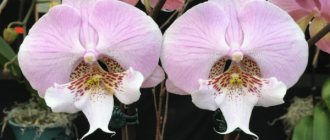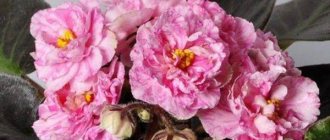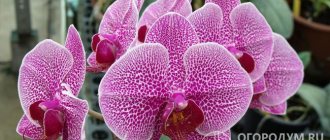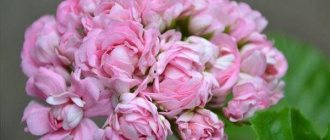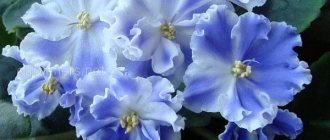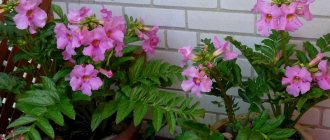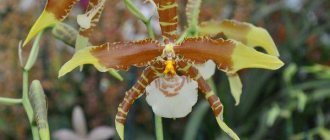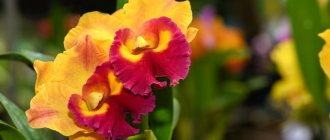Your request has been accepted!
You will receive a notification when the price of the product decreases to the contacts you specified.
Your request has been accepted!
You will receive a notification when the product goes on sale to your contacts.
Orchids are one of the oldest plants on our planet . Due to the fact that they can adapt to different natural conditions, they can be found in different parts of the world.
The most unpretentious orchid, phalaenopsis, is most often grown indoors. If you follow simple rules, it will delight you with its flowering for months.
In this article we will look at the names and photos of varieties of pink phalaenopsis.
Pink Phalaenopsis Rosea
The Phalaenopsis genus includes about 50 plant species. All of them belong to the Orchidaceae or Orchidaceae family. They are distinguished by wide leaves and butterfly-like flowers, the petals of which are complex and painted in pastel colors.
Pink phalaenopsis (Phalaenopsis rosea) is one of the smallest subspecies, an epiphyte . The plant's favorite habitat is river banks.
The rosette consists of 2-5 oblong leaves, up to 20 cm long and about 5 cm wide. On a short peduncle about 30 cm long there are about 15-20 small white-pink flowers , which bloom one after another.
The inflorescence can be simple or branched, arched. The size of the flowers in diameter is 25 mm.
Flower appearance:
- sepals are pink in color with vertical white stripes, oblong;
- the lip is small with three lobes, colored from pink to dark purple.
Phalaenopsis can delight you with its flowering at any time of the year. “Children” regularly appear on faded flower stalks, which can be used to propagate the plant.
Phalaenopsis rosea is native to the lowlands of the Philippine Islands and Taiwan.
More types and varieties of pink phalaenopsis orchids
In the collections of flower growers you can find both species phalaenopsis and hybrid varieties with pink flowers.
Schiller
Among the most common is Schiller's phalaenopsis (Phlaenopsis chilleriana). Homeland - Philippines. The peculiarity of the species is its variegated leaves with a silvery coating, with dark green spots uniting into stripes.
Phalaenopsis Schiller 'Wilson'.
Phalaenopsis schilleriana - photo from Wikipedia.
It is this type of phalaenopsis that is the “father” of most hybrids. The huge number of flowers on the peduncle is another highlight. A record case – 174 flowers on a peduncle!
Stewart
Stuart's phalaenopsis (Phlaenopsis Stuartiana) is very similar to the previous species. The difference is in the branching peduncle with medium-sized flowers with a specific pattern. Its homeland is the island of Mandanao in the Philippine archipelago.
Mini and midi
Phalaenopsis minis are distinguished by their miniature size . Midi orchids are slightly larger - 40-55 cm high, with a leaf length of up to 20 cm and a peduncle thickness of about 7 mm. Among them there are also flowers with a pink color.
Phalaenopsis mini. Please write in the comments what variety it is.
Hybrids
Hybrid varieties of phalaenopsis orchids:
- pink-cherry phalaenopsis;
- pink Dragon;
- blue pink;
- pink Panther;
- pink dreams;
- Grandiflora Chameleon pink;
- royal double pink phalaenopsis.
Phalaenopsis Pink Dragon.
Pink Phalaenopsis Singolo.
Pink Panther (Phal. Pink Panther).
Phalaenopsis Pink Dream (Pink Dreams).
Pink royal phalaenopsis.
Amazing flowers can hardly leave anyone indifferent. Despite their exotic appearance, they are the most unpretentious representatives of the Orchid family. They can be easily found on the shelves of flower shops and apartment window sills.
At home, there are about 70 different plant species , as well as artificially grown hybrids. The varieties differ from each other in the color of the inflorescences, the size of the leaves and the shape of the petals.
If you follow simple care rules, phalaenopsis can bloom for about 4 months, sometimes even 2-3 times a year. Not only experienced gardeners, but also beginners can pacify exotic flowers.
For good growth and development, the plant must create optimal conditions:
- lighting at the location;
- content temperature;
- air humidity;
- watering and fertilizing;
- substrate and transplantation;
- periods of rest and active growth.
Optimal conditions of detention
Phalaenopsis is not too picky about lighting conditions. Still, a more favorable location for it would be under diffused light from the sun , for example, on a windowsill near an eastern or western window.
Direct sunlight can burn the leaves of the plant, so a south window is not the best option for it. If you want to place the plant far from the window, it will need additional lighting with special lamps.
Daylight is desirable until 12 - 15 hours. In winter, it is also useful to use lighting.
Since the plant’s homeland is tropical rainforests, in spring and summer it is necessary to maintain the temperature 20 - 24 degrees Celsius , not allowing it to drop below 18 degrees. From the beginning of autumn until spring – preferably at least 20 degrees.
Phalaenopsis love fresh air with high humidity, but are afraid of drafts. During ventilation, do not allow cold air to enter the plant.
In winter, due to central heating, air humidity decreases, so phalaenopsis must be sprayed frequently. The procedure is carried out carefully, preventing water from entering the rosette of leaves. If an incident occurs, you can extract the moisture using a cotton swab by blotting the core.
In winter, orchids need spraying.
If the tips of the aerial roots are rich green, there are no problems with air humidity.
Watering
The frequency of watering depends on the periods of its development. During growth and flowering, the substrate should be kept moderately moist. From the beginning of the dormant period, the number of waterings decreases, but overdrying the substrate is unacceptable.
Transparent containers in which orchids usually grow will help determine when the plant has rested and entered the growth stage. To do this, you should inspect the roots:
- The green color of the root tips indicates that the plant is beginning to grow;
- During the dormant period, the tips are a uniform brown-reddish-green color.
For irrigation, it is advisable to use soft water at room temperature, which does not contain salt or impurities. Ideal option: distilled, rain or melt water.
Top dressing
Feeding is carried out infrequently, during the growth period once every 20-25 days. In this case, special complex mineral fertilizers for Orchids are used. It should be noted that the period of active growth can occur in any time period.
Transfer
The factor determining the need to transplant a plant into a new substrate is its growth. If growth has slowed down, then the orchid has “outgrown” the container and should be replanted.
The transplantation procedure requires care; it is important not to harm the roots. If possible, the old flowerpot should be cut and the root system carefully removed without destroying the substrate.
The new pot shouldn't be much larger. The choice should be made on a transparent plastic container, because it is also important for the roots to receive light.
It is better to take a soil mixture special for orchids or prepare it yourself from pieces of pine bark, sphagnum moss, charcoal and fern roots.
In general, an orchid is usually replanted once every 2 years, waiting until the end of flowering.
Bloom
The periods of rest and growth of phalaenopsis are not as noticeable as in some other varieties of orchids. Rest is determined by the general condition of the plant.
The dormant period begins after flowering. At this time, it is advisable to reduce the air temperature to 16 degrees Celsius. There is no need to replant or feed the plant.
There is no need to trim the old peduncle. If it has not dried out, you should shorten it by only 2 eyes.
Phalaenopsis blooms almost all year round. In this case, new flower stalks are formed twice a year.
To stimulate flowering, you can “organize” a difference in night and day temperatures for 2-4 weeks, as in natural conditions. This will stimulate the formation of new flower stalks. Before they appear at night it should be 16-18 degrees, after - 20-22 degrees.
But from overwatering, the roots of the plant can suffer and rot. In such a situation, transplantation into a new container and a new substrate is necessary.
After purchasing in store
When purchasing an orchid in a store, you should pay attention to its general condition, roots and peduncle. In healthy specimens, the leaves are elastic, dark green, do not wrinkle, the roots are green or grayish, the aerial roots are hard and elastic.
The peduncle should have blooming flowers and buds. There should be no rot in the socket.
Varieties: photos and descriptions
There are many varietal varieties of this color of phalaenopsis. Each variety has its own characteristics that distinguish it from others.
Phantom
The Phantom variety is distinguished by a special petal pattern that resembles a mesh. On flowers of a white, milky or light beige hue, you can clearly see a mesh pattern of raspberry or dark cherry tone. The plant's lip is usually red or burgundy in color. The appearance of the flowers is standard for phalaenopsis - they all have the shape of a butterfly.
Emperor's Pearl
Phalaenopsis with the exquisite name Emperor Jewel is also sometimes called Jewel.
This plant is classified as a monopodial epiphyte.
The stem height of this variety can reach 35–40 cm. The leaf blades are arranged in two rows at once (the leaves are dark, fleshy and long – 20–30 cm). The peduncles of the variety are elongated and large (exceed 62 cm in length). The flowers are also large (7–8 cm), painted in a crimson hue, but in the core of the bud the color begins to lighten and reaches pale pink. Has no smell.
Pretoria
The Pretoria variety (Phalaenopsis Anthura Pretoria) has an original flower color. The peculiarity of the gradient of the buds (from dark crimson or purple in the core to light pink or almost white along the edge) makes the flowers almost velvety in appearance.
The buds of the variety are quite large (8–9 cm), the leaves are elongated and long (16–20 cm), colored in a dark green shade. The bush itself is quite tall (up to 50 cm in height), so it will require a sufficient amount of space for growing.
Rome
Phalaenopsis Rome (Rome) is quite large with a sharp and noticeable aroma. The flowers are medium in size, painted in a delicate pink shade. The lip can be painted the same color as the petals of the buds, or have a darker shade (the color of a dusty rose).
Octopus
The Octopus variety is also called Octopus. An original variety that combines shades of pink and yellow. The flowers are large, painted light yellow or beige and dotted with a large number of crimson or burgundy dots. A scattering of bright inclusions is usually concentrated in the core of the flower, creating an original pattern.
Salinas
The Salinas subspecies of indoor orchids is quite demanding in terms of temperature growing conditions.
The plant is not too large, the flowers are medium in size (5–7 cm). The petals are painted in a delicate pink shade, which stretches from the border to the core with a barely noticeable transition from light to dark shade. The lip is colored yellow and dotted with a large number of crimson dots.
This variety is often confused with the Chengdu variety. You can find out what the differences are and more information about the features of the Chengdu phalaenopsis here.
Dragon with orange lip
One of the most popular subspecies of this color of phalaenopsis, Pink Dragon (Phalaenopsis Pink Dragon) belongs to the hybrid or mix varieties. It is distinguished from others by a specific mosaic pattern that completely covers all the soft pink petals. The dots scattered over the entire area of the flower are colored in a rich crimson or lilac hue. At the same time, the bow-shaped core of the bud is convex and colored golden yellow or orange.
Pink Girl
An equally popular variety of home orchid, Pink Girl (Phalaenopsis Pink Girl), is distinguished by its external fragility and tenderness.
The petals of the buds are painted light pink, but have a white edge. Flowers exude an unobtrusive and pleasant aroma throughout the day. The leaf blades are dark green with light brown splashes.
Romance
Hybrid Romance (Phalaenopsis Pretty Romance) is distinguished from others by the special largeness of its flowers, as well as their interesting coloring. The buds themselves of phalaenopsis are white, but the petals are densely dotted with small bright pink dots, which create an original contrasting pattern. The lip of the plant is dark pink or crimson.
Cosmopolitan
The phalaenopsis variety Cosmopolitan is distinguished by large (8–9 cm in diameter) two-color flowers. The petals of the buds have a light pink background, on which a purple or crimson pattern of veins stands out. The lip has a pronounced bright pink edging and a white core with yellow veins.
Pulcherima
The Asian variety of domestic phalaenopsis Pulcherrima (Phalaenopsis Pulcherrima pink) belongs to the group of midi varieties with a peloric flower shape. Peduncles reach a length of 30–40 cm, but the diameter of the flowers is very small (3–4 cm). The shade of the petals is predominantly bright pink with a lilac undertone. The lip is white or pale pink.
Cleveland
Phalaenopsis Anthura Cleveland is somewhat reminiscent of the Cosmopolitan variety. The lighter petals of this flower are also covered with a large number of bright pink veins, creating an original pattern. However, in this subspecies the background color is presented in the form of a gradient (the color stretches from darker in the core to almost white at the border). The flowers are large (up to 9 cm in diameter), but the inflorescences are not too long - only 20–22 cm.
Pasadena
Phalaenopsis Anthura Pasadena can have large purple, hot pink or lilac flowers. The peduncles are straight and graceful, holding open buds for a long time, bordered by long rosettes of leaf blades.
Potter
One of the rarest varieties of this color of phalaenopsis, Potter, is difficult to find on the open market. The flowers of this subspecies have an original color - the entire space of the petals is dotted with specks, stripes and edgings of a bright crimson hue. The buds themselves are not too large, but the leaf blades are particularly elongated.
Angelina
Hybrid Angelina (Phalaenopsis Charming Angelina) appeared relatively recently (in 2018).
This variety is classified as the Big Lip subspecies based on the shape of its lip (“big lip” – big lip).
The medium-sized flowers are light pink or light lilac in color. In the core of the bud you can see a small pattern of crimson dots, which is also repeated on the large white-pink lip with a yellow center.
Los Angeles
Phalaenopsis Anthura Los Angeles is distinguished by a special shade of flowers, which is closer to lilac. At the same time, the entire space of the petals is strewn with small specks of crimson color. Belongs to the Multiflora group. This variety has a well-developed root system, which allows it to thrive even in unfavorable conditions.
Dusty belle
Phalaenopsis Dusty Belle is an extremely fragrant and vibrant phalaenopsis with distinctive red-purple petals edged with yellow. It is quite possible that the flower inherited such an unusual color and noticeable aroma from its natural “parent” - Schiller’s phalaenopsis.
Sanderiana
Endemic Sanderiana has a very small growing range.
It is one of the rarest and most expensive varieties of pink phalaenopsis.
The short peduncles of this variety can accommodate 15–50 flowers with a diameter of 5–9 cm. The color of the petals can be different. Variants of purple, pink, light pink shades are known. The lip of the flower can be white, yellow or light brown with red splashes.
Cute Holly
Phalaenopsis Cute Holly is not the most spectacular variety of all mentioned. Belongs to the subgroup of midi-phalaenopsis. The peduncles are low, the flowers are medium-sized, painted in a bright crimson or purple hue. The lip of the bud can be lilac or purple.
Angel
Phalaenopsis Jiuhbao Angel is a large-flowered hybrid with unstable bud color. There are 4 variations of flower shades in this variety. It takes root well in indoor conditions, but requires strict adherence to care standards.
Legato
This orchid has large buds that are delicate and silky to the touch. Inflorescences can range from pinkish-beige to golden-lemon shades. Read more about the Legato orchid here.
Manhattan
Another hybrid variety from the pink phalaenopsis family is Manhattan (Phalaenopsis Manhatten). It is often confused with the Philadelphia and Pink Dragon varieties. In this species, crimson specks on pink petals create an unusual marble-like pattern. You can read more about the variety here.
Schilleriana
Phalaenopsis schilleriana. This variety and its hybrids are distinguished by their unusual colors and leaf shapes. You can see stripes or a silver tiger pattern on them. Read more about Schiller's phalaenopis in this article.
Read about other colors of phalaenopsis: Red and burgundy, Yellow, White
There is a myth that phalaenopsis plants are not suitable for beginners to grow. However, these are prejudices. There are many varieties of home orchids that even beginning gardeners can handle. For example, you can choose a suitable flowering pet from a large number of varieties of the popular pink phalaenopsis species. Many of them are undemanding to care and have an original bright color.
Classic varieties of pink orchids with photos
Today you can find a large number of varieties of pink orchids at the flower market. Almost all of them require the same care. Thus, you can choose based on your own preferences. However, you need to understand that it is better to purchase planting material in specialized stores. There he is not infected, so he can live for quite a long time. It is worth taking a closer look at the most popular varieties.
Schiller
This is the most common flower that can be found among domestic plant growers today. It also grows in the natural environment.
Here are the features of this type:
- The plant can reach 100 cm in height.
- The root system is quite developed.
- The leaves completely hide the stem. They are bright green. Wiry, the size can reach 60 cm in length and 10 cm in width.
- The flowers have a delicate pink color. They are small and there are a lot of them. The recorded record is 174 flowers on one peduncle.
Stewart
The variety is very similar to the Schiller orchid. However there are a few differences:
- The peduncle is quite branched;
- it has a specific design;
- The flowers themselves are lighter, there is also a white tint.
Caring for this plant is standard, so it should not cause any difficulties. When creating optimal conditions, flowering can be achieved within five months.
Rosea
This is one of the most popular varieties; its small seedlings resemble butterflies in appearance.
Here are the characteristic features of this plant:
- The peduncle can reach 50 cm.
- The leaves are medium in size, rarely exceeding 30 cm in length. They completely cover the stem.
- The flowers are pale pink. Their diameter is no more than 3.5 cm.
- The buds open gradually, allowing you to enjoy long-lasting flowering.
Mini phalaenopsis
This is a unique orchid that has the following characteristics:
- The size of the peduncle does not exceed 20 cm.
- The buds are pink and may have different patterns on the petals.
- The lip is standard, like the Schiller and Stewart varieties, but smaller.
Phalaenopsis varieties
Charming blue butterfly orchid
Breeders have been developing new varieties of royal flowers for a long time. Among them there are very rare plants. They cost a fortune.
For those new to growing, hybrids are recommended. They are easy to care for and do not require close attention.
Pleasant or Amabilis
Phalaenopsis Amabilis: white flowers with a light lilac coating on the edge of the petal
Pleasant or Amabilis
The fleshy leaves of phalaenopsis are dark green in color, arranged in 2 rows. The peduncles are long, curved in shape, and can reach 0.5 m in length.
A replacement peduncle immediately develops in place of the cut peduncle. Phalaenopsis Amabilis is a fertile material for crossing. It is this beauty that is the progenitor of many new varieties.
Flowering is long lasting. Flowers appear mainly in autumn.
Pink (Rosea)
Pink (Rosea)
Pink (Rosea)
It is considered a miniature plant. Bright pink or white flowers do not exceed 3 cm in diameter and are located on a peduncle 30 cm long.
Schilleriana
Schilleriana
Schilleriana
The beautiful exotic foliage is completely covered with silvery spots, the bottom of the leaf has a reddish tint. Huge flowers, reaching a diameter of 7 cm, hang in a beautiful cascade from long peduncles. Stems can be 0.5 m long.
Stuart (Stuartiana)
Stuart (Stuartiana)
Stuart (Stuartiana)
An interesting plant with variegated foliage and silvery roots. The variety has gained popularity due to its abundant flowering: up to 60 snow-white flowers decorated with purple spots can bloom simultaneously on one peduncle.
Hybrids
There are many hybrids among orchids. These are varieties that were bred through selective breeding. They do not grow in the natural environment, but they are better adapted to life in indoor conditions than others. That is, this culture does not react so quickly to changes in external factors, making it more suitable for novice gardeners.
The Dragon
This is one of the most popular hybrids today. Here is a brief description of it:
- The height of the peduncle can reach 60 cm.
- The stem is thin, dark in color, completely hidden by leaves.
- The leaves are hard and bright green. There can be up to six of them.
- The flowers have a typical orchid shape. Delicate, pink. There are a large number of dark dots on the petals.
- The lip is yellow-white. There are also dark spots on it.
This plant has extraordinary beauty and is also very easy to care for. That is why many gardeners today prefer to grow this particular variety of orchids at home.
With white spots (Panther)
This is another classic orchid hybrid that was obtained through selection. It is not found in the natural environment.
Externally, the flower is similar to the Dragon orchid, but there are differences:
- five petals white;
- there are a large number of pink spots of different shapes and sizes on the petals;
- the lip is completely pink, separated from the main flower by about two centimeters.
The panther is an incredibly beautiful flower, which at the same time requires standard care. The height of the peduncle can reach 60 cm.
Royal terry
This orchid is a little different from all the others. Here are its features:
- The size of the plant reaches one meter.
- The flower is regular in shape, completely pink. There are no inclusions on it. The buds are large and emit a pleasant aroma.
- The flowers are light and beautiful, pink in color.
Rules for planting and propagation
Experienced plant growers know that the growth rate of an orchid and its condition depend on proper planting. It is impossible to achieve flowering if the crop does not receive everything it needs.
The landing process itself is standard, but there are some nuances:
- Only a transparent pot is used. This can be an ordinary plastic container or container.
- A special soil is poured into it, which you can buy or make yourself. If you want to perform all the operations yourself, you will need to mix tree bark with moss, add lowland peat and charcoal. It is imperative to provide a good drainage layer, because stagnation of moisture is detrimental to the orchid.
- The orchid is removed from the old pot and placed in a new one.
- Sprinkle a little soil on top without completely covering the aerial roots.
A domesticated orchid can be propagated in the following ways:
- dividing the bush;
- basal children;
- cuttings;
- children on a peduncle;
- seeds.
The flower does not tolerate external influences well, so you can divide the bush only not during flowering. Otherwise, it will take a long time for the culture to fully recover. Moreover, the plant will not produce flower stalks for the next year or even two.
Care
The rules for caring for a spectacular sissy are quite simple, the main thing is to strictly follow them.
Selecting a location
You need to choose a place to place the plant based on lighting and ventilation. There should be a lot of light, but you need to make sure that it is diffused. It is better to give preference to the eastern and western sides. You can also place it on the south side, but in this case you should shade the flower from the scorching rays during hot hours. This can be done with a simple sheet of paper. Also do not forget about ventilation. But do not allow drafts to form.
Pot and substrate
Beginning flower growers are advised to buy ready-made soil. It contains all nutritional elements balanced. For those who want to prepare the substrate themselves, you need to take the following components:
- sphagnum moss;
- peat;
- bark (pine or spruce);
- sand (large sizes).
It is necessary to mix all the ingredients in equal proportions. Don't forget about the drainage layer. It helps protect against moisture stagnation.
The pot should be transparent and smooth
This is an important condition, since the root system takes part in the process of photosynthesis, and also to ensure that the roots do not grow into the surface of the flowerpot.
Temperature
The optimal maintenance temperature for all phalaenopsis is considered to be 25-30 degrees Celsius during the period of active growth and development. During rest, the plant needs to lower the temperature slightly – to 18-23.
Don't forget about daily temperature changes. The difference between day and night should be about 3-5 degrees.
In order to provide warmth for orchids, you should not place flowerpots with flowers on heating devices. They very dry the air, as well as the root system.
Humidity
Since the orchid comes from tropical countries, this plant needs to be provided with relatively high air humidity. It should fluctuate between 60-80%. To provide the flower with this condition, you need to spray the air around the phalaenopsis more often, as well as the plant itself
It is important to prevent water from entering the leaf rosette
Experienced gardeners do not recommend spraying the plant during the scorching sun, so that drops of water do not turn into sources of light.
Another way to humidify the air is to place a container of water near a flowerpot with a flower.
Lighting
We have already said that phalaenopsis requires a lot of light. Therefore, you need to place it in a well-lit place. Another condition is to maintain the light regime for 10-12 hours a day. To do this, in the winter season you will have to use artificial lighting.
The main thing is not to resort to lamps that heat up during operation. Such lighting devices can burn the entire plant.
Watering
Moistening the soil should occur once a week, or even less often. But every case is considered exceptional. Therefore, you need to look at the condition of your plant. If the roots have acquired a silvery tint and the soil is dry, then it is time to water.
This can be done in two ways: immersion or watering.
You need to immerse for no longer than a third of an hour. In this case, you can also add fertilizer to the water. But you don't need to do this every time. Maximum – twice a month. And while spraying, you can refresh the orchid and carry out hygiene procedures - wipe all the leaves.
Top dressing
Phalaenopsis Schiller needs to be fertilized twice a month during active growth and development. For this, it is better to use ready-made complex fertilizers, which are sold in a specialized store. Their advantage is their balanced composition, which is suitable specifically for the Orchid family.
If the plant begins to bloom, fertilizing should be completely eliminated. But after the last buds fall off, you need to apply fertilizer only once a month. This regime must be followed for two to three months. And after the specified time has passed, you need to return to twice-daily fertilizer.
Transfer
The orchid’s “place of residence” needs to be changed every two to three years. During this procedure, you need to change the soil. The soil can first be placed in the microwave for a few minutes or in the freezer for a couple of hours. This manipulation will help disinfect the substrate.
It is worth purchasing a pot for replanting that is only a couple of centimeters larger than the previous one.
We invite you to watch a video about transplanting the Schiller orchid:
We have prepared for you useful information about different varieties of phalaenopsis: Mix, Big Lip, Wild Cat, Multiflora, Liodoro, as well as yellow, white, pink, blue.
Features of care
It is necessary to properly care for the orchid so that it blooms profusely and delights with its rapid growth. To do this, you need to pay close attention to some factors:
- illumination;
- air temperature;
- watering;
- feeding
It is worth considering all this in more detail.
Temperature and lighting
Orchids are very sensitive to light. They need a lot of light, so it is recommended to place them on the south side. At the same time, plants are afraid of direct sunlight, so the light should be diffused. If the orchid has just been purchased, it must be placed in a dark room for a couple of days so that it can acclimatize faster. Only then is the plant provided with sufficient light.
As for temperature conditions, here are the basic rules to remember:
- during the day the temperature is up to +27 degrees;
- at night about +18 degrees;
- Changes of more than five degrees are prohibited, after which the orchid will get sick and drop its leaves.
Thus, being in an apartment allows the culture to feel comfortable at any time of the year.
Watering and fertilizing
Orchids need a lot of moisture in the air, but there is no need to flood them. Otherwise, there is a high risk of rotting roots or leaves.
Here are the basic rules for watering:
- It needs to be watered once every 7-10 days.
- During the flowering period - less often, every 10–12 days.
- If it's hot outside, watering is done every 2-4 days.
- You can determine whether it is necessary to water by looking at the top layer of soil: if it is dry, it should be moistened.
- Spraying is required periodically. However, water should not get into the rosettes of the leaves, as this can cause rotting.
The plant definitely needs feeding. You can find fertilizers for orchids in specialized stores. It is required that they have enough potassium, phosphorus and superphosphate. Fertilizers are applied exclusively in liquid form every 20 days. The first time you need to dilute less substance than indicated in the instructions. This is necessary to check how the orchid will react to feeding. If no side effects are detected, you can fertilize according to the instructions.
During the flowering period
During flowering, the crop consumes a large amount of minerals. Also, the flower is highly susceptible to external factors.
Therefore, a blooming orchid must provide the following conditions:
- optimal temperature conditions;
- proper watering;
- more abundant feeding.
It is forbidden to move the plant during the flowering period or carry out any manipulations on it: replanting, cuttings, etc. It can quickly shed all its buds and begin to fade. Therefore, you first need to wait for the end of flowering, and only then carry out the planned actions.
Care
The orchid is a capricious plant that requires strictly defined conditions for its maintenance:
- Temperature conditions. The plant requires a minimum of 20oC in winter and up to 35 in summer. Temperatures dropping to 100 at night can kill a pink orchid.
- Location. Pink Phalaenopsis does well on windows facing east or west.
- Light. In winter, the plant requires additional lighting using fluorescent lamps. The pink orchid requires 12 hours of daylight for normal growth.
- Watering. Pink orchids require moderate watering. In summer, they are moistened as they dry - two to three times a week; in winter, the volume is reduced to several times a month. The water should be settled and at room temperature.
Top dressing
The pink orchid must be fertilized with a complex product for orchids. It is added to the moistened substrate so as not to burn the root system. Too much fertilizer can lead to cracks in the leaves and lack of flowering. When choosing a fertilizer for a flower, you need to choose one with the lowest nitrogen content.
Transfer
Moss, pine bark, and charcoal are used as soil for pink Phalaenopsis. Plants are planted in transparent plastic pots to control the position of the roots, monitor the need for moisture, and prevent the plant from dying off.
Transplantation is carried out only when absolutely necessary, once every few years. The procedure is performed only after flowering. The bottom of the pot is covered with drainage. Dried roots are cut off and the old soil is cleaned out. The orchid is placed in a new pot and carefully covered with substrate, without pressing it to the roots.
We invite you to watch a visual video about orchid transplantation:
Reproduction
Daughter plants can be separated during transplantation. Orchids can also be propagated by children that sprout on the flower. Young inflorescences will appear after about a year.
Pests and diseases
- The most common problem with pink Phalaenopsis is root rot. The flower can be saved by timely pruning of the affected areas, replacing the soil and reducing the amount of watering during the recovery period.
- The orchid is susceptible to attacks by aphids and red mites, which spread from a diseased plant to a healthy one. When purchasing a flower, you need to carefully examine the leaves and flowers; you can notice damage from the mealyworm on them when infected with parasites.
The pink orchid is a rather capricious plant to care for. However, if you follow all the above recommendations, a flower “like a moth” can bloom on your home windowsill, which has delighted the eyes of scientific botanists and ordinary people for hundreds of years.
Diseases and pests
Periodically, the orchid is attacked by various pests:
It's quite difficult to fight them. If a thin mite leaves the plant when air humidity rises, then other pests need to be fought by destroying their eggs. For this, special poisons are used . However, they must be used in small quantities so as not to harm the culture itself.
As a result, the effectiveness of control is reduced, but the flower is preserved. To get the desired result, it is necessary to carry out not 2-4 sprayings, but about eight due to the reduced dosage of the chemical.
Thus, pink orchid varieties require standard care. It is recommended to buy soil in special stores to avoid problems with pests. With proper care, they will not appear, and the flower itself will feel great.
If the leaves begin to turn yellow, it is necessary to adjust the intensity of watering. If there is root rot, it is necessary to dry them and replant the plant. The flower will thank you for your care with long and intense flowering, which can last for several months.
Conditions and care
According to the description, the stone variety of orchid needs high-quality and regular care, otherwise the crop not only ceases to please with its appearance, but also dies
It is for this reason that it is so important to choose the right container for planting, substrate, set up an irrigation system, choose a permanent place for further growth, and much more.
Capacity
The choice of container is approached responsibly, since the root system is an integral element of photosynthesis. It is for this reason that a transparent container made of glass or plastic is perfect. Drainage is used as desired.
Accommodation in an apartment
If you plan to grow a stone variety of orchid at home, then favorable conditions must be created
The place where the culture will be located is of no small importance. Thus, it is recommended to choose a shaded place
Direct sunlight should not touch leaves or flowers. You can place the pot away from the window, but then additional artificial lighting will be required. The duration of daylight hours deserves special attention, which should not be less than 12 hours, otherwise the flowering period may not wait.
Temperature and humidity
The “Stone Rose” orchid needs high-quality care, which depends on the time of year. Thus, in the summer, the peak of beauty occurs, so in the shade the temperature should not exceed +20 degrees. If the temperature is higher, the buds will begin to fall off. In winter, when flowering has not yet begun, +15 degrees is sufficient. When the first flower stalks begin to appear, the temperature is increased by 5-6 degrees.
A high level of humidity is not required, so you should not spray the orchid daily, as this can lead to rot. The optimal humidity level is from 45 to 50%. If in winter the humidity level drops below the permissible level, then spraying the leaves is allowed.
Advice! Water should not get on the flowers.
Watering
There are several ways to water a stone orchid, the most popular are:
- The pot with the plant is immersed for some time in a container filled with water.
- Water to the very roots in the shower.
During the flowering period, it is best to water at the root, which will allow you not to disturb the flower again, and also not to change the original location, since orchids can quite easily shed their flower stalks.
Watering must be moderate
It is important to ensure that the root system is not constantly in water, as this can lead to a number of diseases. Thus, many experienced gardeners recommend letting the roots dry out a little.
If flowering has not yet occurred, the plant is immersed in water. To do this, lower the pot into another container and wait until air bubbles stop appearing
After this, it is important to completely remove excess water. For irrigation use water with a temperature of +29 degrees
It is not recommended to use liquid with high humidity levels.
Top dressing
For this variety, it is recommended to use fertilizers specifically designed for this purpose, sold in specialized stores. During flowering, fertilizing is applied several times throughout the month in small dosages. If flowering occurs in autumn or winter, then the amount of fertilizer must be reduced by 2 times. Since salt deposits may begin to accumulate in the soil, the substrate is washed monthly under running water for 20-25 minutes.

